XFX’s Radeon HD 7970 Black Edition Double Dissipation: The First Semi-Custom 7970
by Ryan Smith on January 9, 2012 6:00 AM ESTOverclocking
Though XFX does not provide any overclocking tools for the BEDD, the card itself is advertised as an overclocking card to an extent. The use of the AMD PCB and a similarly high performing cooler means that overclocking results shouldn’t be much better or much worse than reference cards, but given how much potential we’re seeing out of the 7970 this is not a bad thing.
Even with XFX’s factory overclock the BEDD features the same 1125MHz overdrive limit as all current 7970 cards, so you have 125MHz (~11%) to play with within Overdrive. Based on our experience this is right at the edge of what’s this card is capable of – after pushing the card to 1150MHz through MSI’s Afterburner software we found that our sample peaked at 1125MHz anyhow, as anything beyond that impacted stability and caused artifacts. Meanwhile we were able to push our memory to 6.3GHz, as beyond that point performance plateaued as the need for error correction nullified our gains.
Our final clocks were 1125MHz core and 6.3GHz memory, representing a 21% core and 14% memory overclock over the reference 7970, or an 11% core and 11% memory overclock over XFX’s factory overclock. As the BEDD uses an AMD PCB it should be possible to use compatible voltage tweaking software to push it further, but for the time being we’re limiting ourselves to what the 7970 can do on stock voltage as the AMD PCB isn’t particularly overbuilt for overvolting. On that note we did increase our PowerTune limit to +20% (300W) in order to ensure PowerTune didn’t throttle our overclocked BEDD, though there appears to be headroom to spare in at least some of our games.
| Radeon HD 7970 Overclocking | |||||
| Radeon HD 7970 Stock | XFX Radeon HD 7970 BEDD | XFX Radeon HD 7970 BEDD Overclock | |||
| Core Clock | 925MHz | 1000MHz | 1125MHz | ||
| Memory Clock | 1.375GHz (5.5GHz effective) GDDR5 | 1.425GHz (5.7GHz effective) GDDR5 | 1.575GHz (6.3GHz effective) GDDR5 | ||
| Voltage | 1.17v | 1.17v | 1.17v | ||
| PowerTune | 250W | 250W | 300W | ||
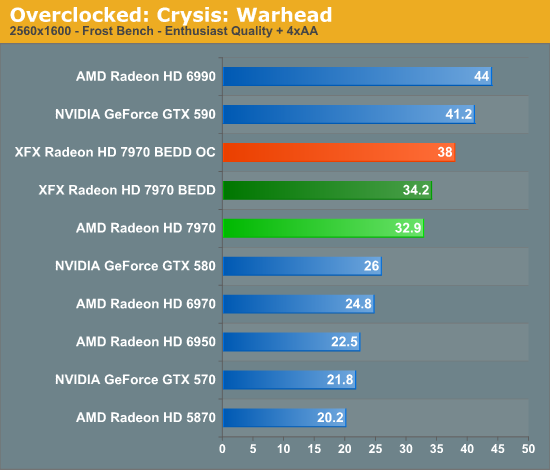


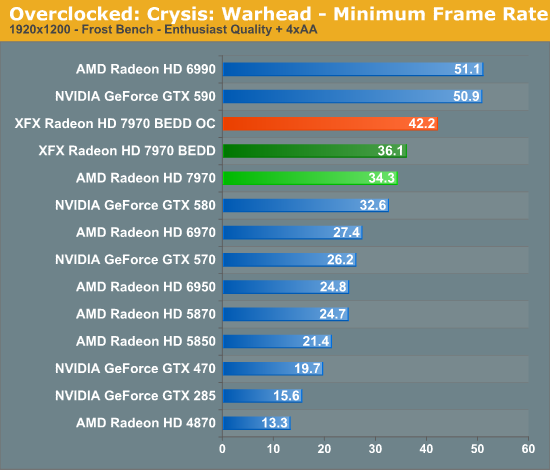
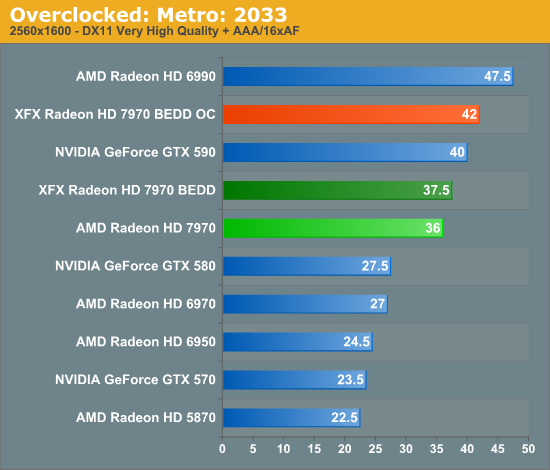

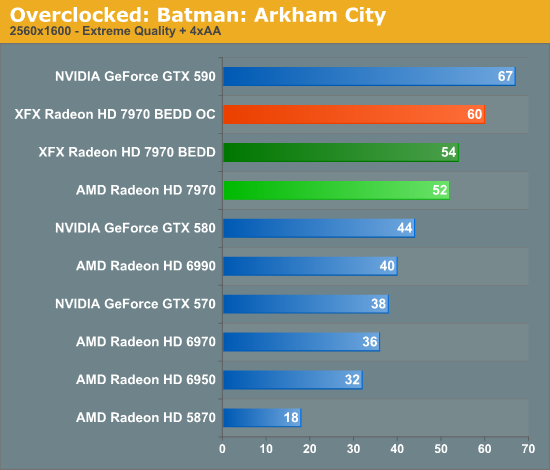
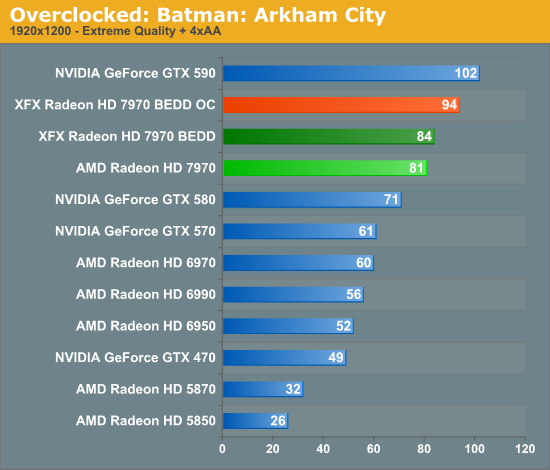
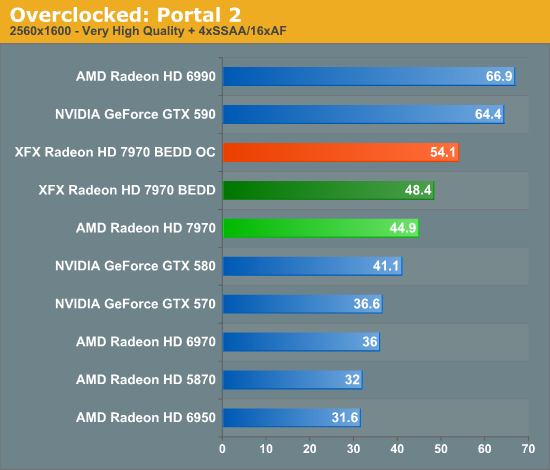
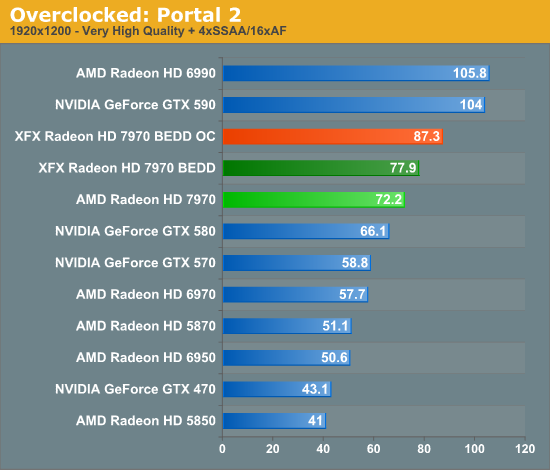
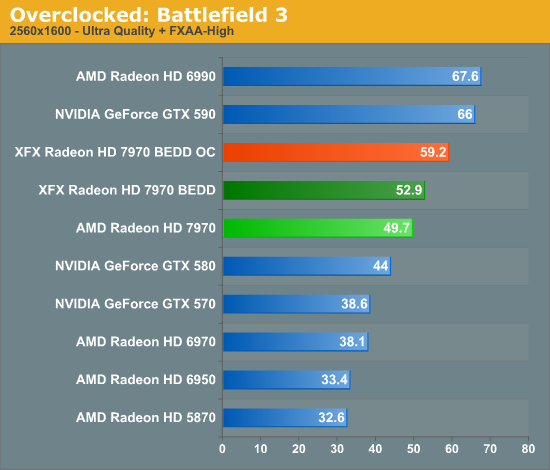
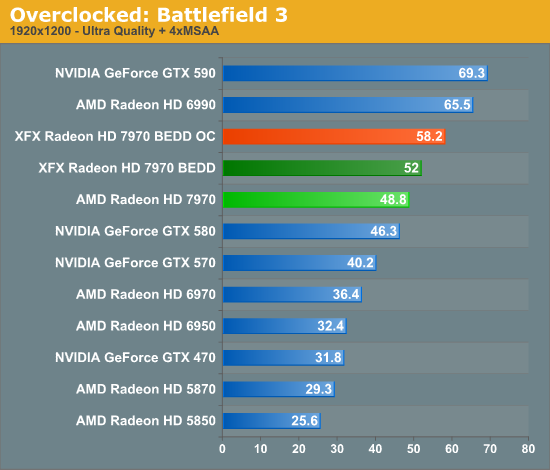
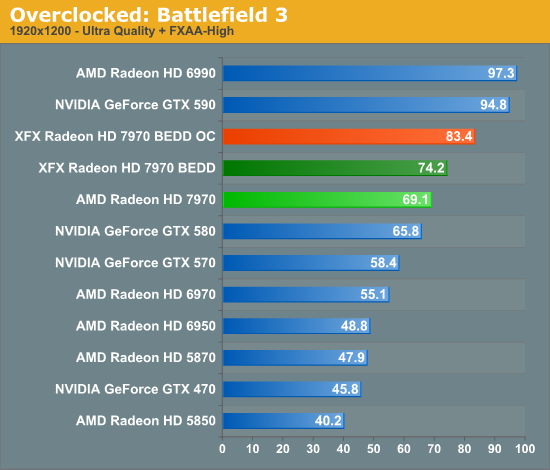
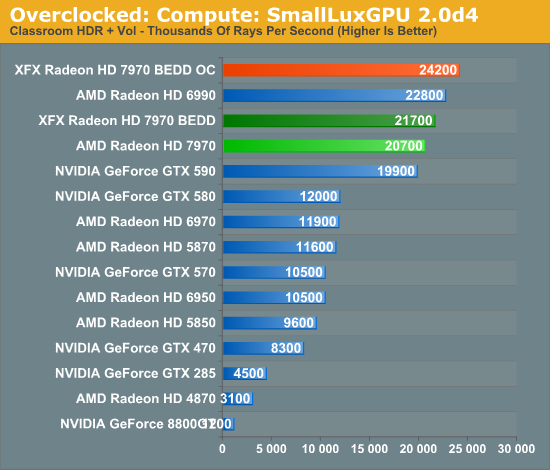
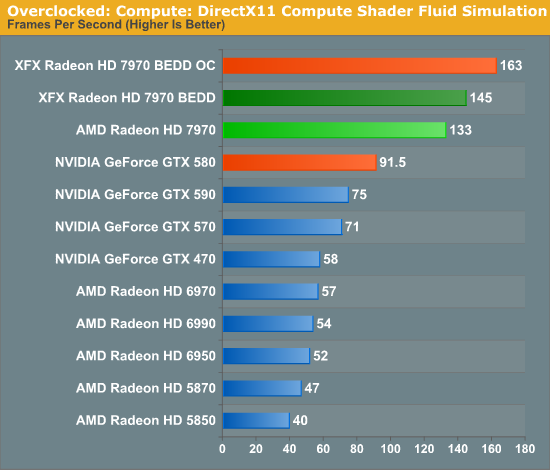
The end result of a further 11% overclock to both the GPU and memory clock results in a very consistent 11% performance increase across the board. From Crysis to Battlefield 3 everything jumps up by 11%, and the combination of the two overclocks means that our overclocked BEDD leaves just about every other single-GPU video card in the dust. Even the dual-GPU 6990 and GTX 590 have their leads seriously eroded, and in a few cases the overclocked BEDD will pull ahead of the GTX 590 in games that AMD does particularly well in. If the reference 7970 and BEDD didn’t impress you, certainly this will.
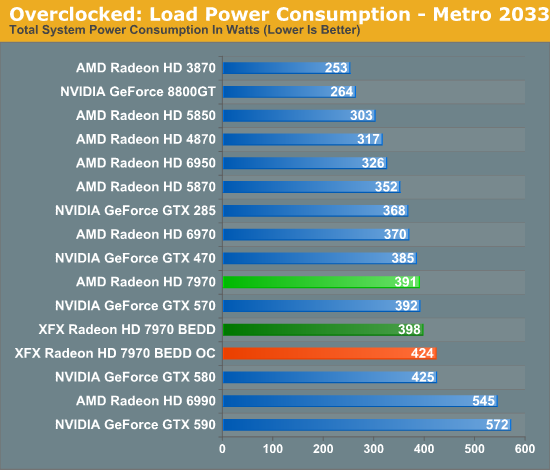
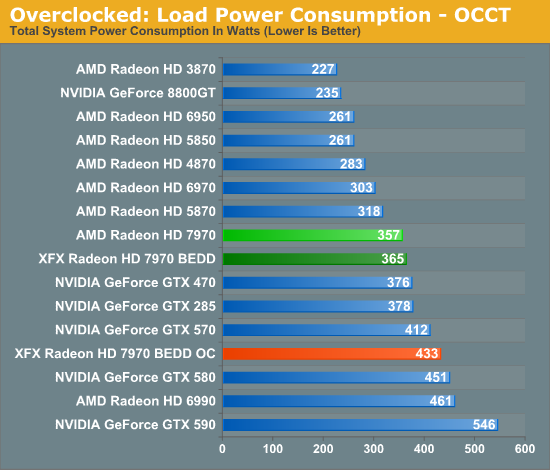
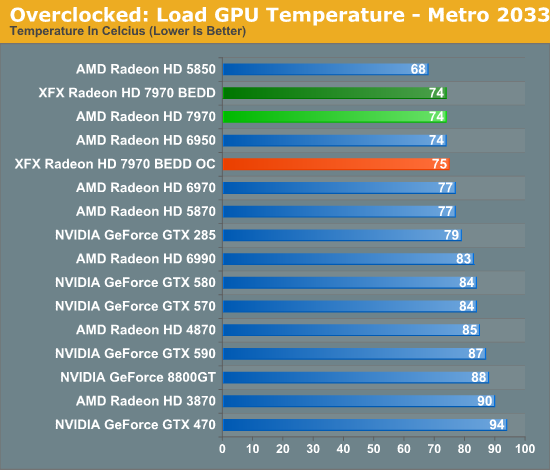
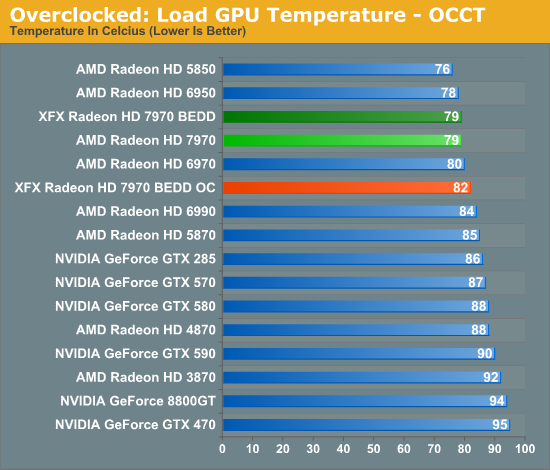
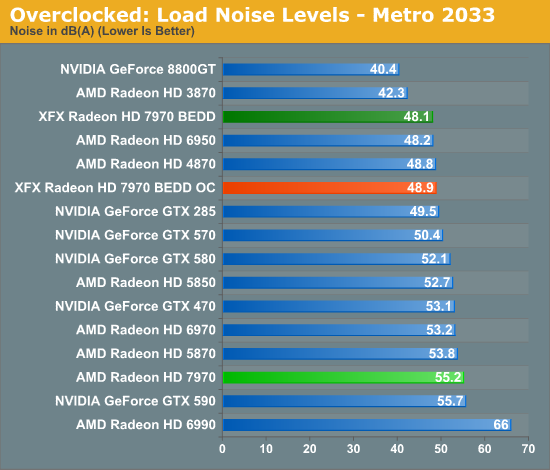
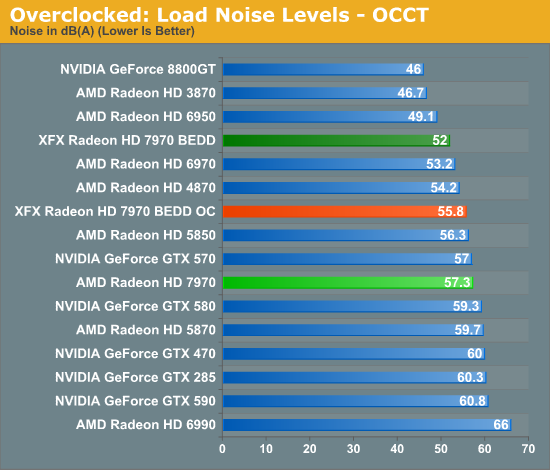
So what’s the tradeoff for this overclock? It’s actually very little. Even with our increased PowerTune limit – which doesn’t increase the power consumption, just the potential for power consumption – power consumption under Metro only rises 26W, and at least some of this will be additional work on the CPU in response to the relaxed GPU bottleneck. OCCT looks worse, but again this has more to do with the PowerTune limit than the overclock.
The fact that this overclock has had a minimal impact on the power consumption of our BEDD is reinforced by our temperature and noise data. Under Metro the overclocked BEDD gets 1C warmer and 2dB louder versus its factory clocks, which is a very small increase given the 11% overclock. So long as we don’t touch the core voltage for the BEDD (or any other 7970), the power tradeoff for overclocking is nearly non-existent, which is fantastic news given that we’ve just driven a 7970 21% over AMD’s reference clocks on reference voltage.










93 Comments
View All Comments
chizow - Tuesday, January 10, 2012 - link
Also to this:"Gtx 460 and 560 ti were failure compared to AMD's offerings - in terms of performance."
Contradict yourself much? If this is true, then you're admitting every single GPU AMD has created since G80 is a failure compared to Nvidia's offerings and directly contradicting the points you're trying to make with regard to price and performance.
Sorry, you can't argue out of both sides of your mouth, the message just comes out a big jumbled mess.
wifiwolf - Tuesday, January 10, 2012 - link
I think with this post you're just saying he was right all along.And I agree. It's just business, you just choose where you you want to place your product: On profits or brand.
chizow - Tuesday, January 10, 2012 - link
No, I don't agree with any of that because its clearly off-base and out of place in a discussion about high-end performance parts.What drives pricing in this segment? This is a simple answer.
Performance. That's all that matters.
Performance/watt and performance/dollar are just tertiary considerations that take a back seat to secondary considerations like feature sets and application support. You win these "value" market segments not because you want to, but because you have to when you can't win without compromises.
wumpus - Tuesday, January 10, 2012 - link
DPFlops/Watt matters if Fermi and Kepler were designed for GPU computing. Nvidia makes a ton of money there, and doesn't have to compete with AMD nearly as much as in graphics.DPFlops/Card seem to matter more. I suspect that DPFlops/Card matters most (due to IO issues) than DPFlops/$ (once known as machoflops, mostly for govt/academic epeenwaving).
Now that both companies appear to be designing for GPU computing, it will be interesting to see how they compare (even if the 7970 seems to be missing half of its DPFlops. I wonder if they managed to de-power the transistors if they are there).
chizow - Tuesday, January 10, 2012 - link
DPFLops/Watt discussions have a place, but not for desktop GPU parts branded GeForce or Radeon. If this were a Tesla part it'd be more meaningful.Nvidia cripples DP performance pretty badly on their GeForce parts starting with Fermi and I imagine they will do the same for Kepler. It also sounds like AMD is doing the same for Tahiti, but it will be some time before we have any idea if GCN is even directly competitive in real world GPU compute applications.
Benchmarks and synthetic tests look great, but its going to take quite a bit of effort for AMD to get any penetration in a HPC market Nvidia has clearly dominated. Nvidia basically had to create their own API and GPU compute market from scratch, so AMD has their work cut out for them to catch up.
Jediron - Wednesday, January 11, 2012 - link
No, not the Champions of the poor. But yes, Champions of the single core Videocard!GTX580, you lose.
Sure the ball lies in Nvidia camp now, no suprise there! The ball was in AMD's camp, and they scored; that is obvious.
Long live the red camp :-)
mhampton - Monday, January 9, 2012 - link
Page 2 of the article starts by listing the setup tested, and the CPU must be a misprint - as far as I know there is no "i7-3936". Presumably this should be 3960 or 3930 instead.know of fence - Monday, January 9, 2012 - link
The same 3936 misprint can be found here:http://www.anandtech.com/show/5261/amd-radeon-hd-7...
Ryan Smith - Monday, January 9, 2012 - link
Noted and fixed. Thank you.BenSides - Monday, January 9, 2012 - link
I agree with a poster above, who is apparently content running a single 5850 paired with the latest game releases. I have 2 5870's in crossfireX, in conjuction with an old i7 950 cpu. My benchmark results (Crysis) blow this new thing (7870) to hell.While not a gamer, benchmarking is a hobby of mine. Looking at the results here at Anandtech, it is reassuring to know that with the elderly cards I have, it seems there is nothing, at the present time, or looming on the horizon, which would make my graphics cards obsolete.
In short, until AMD or NVIDIA introduce some revolutionary new technology, you're fine with your current card(s), if the presented benchmarks are any indication. Seems to me that at the present time, NVIDIA and AMD are producing new graphics solutions which are just overclocked versions of *old* graphics solutions.